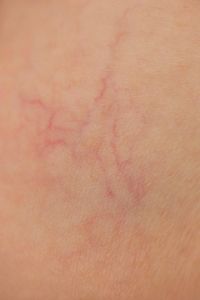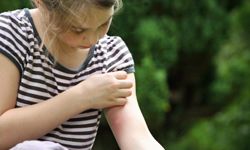It's easy to spot broken capillaries, particularly on someone's face. Dozens of tiny veins twist, dilate and break, creating red, bruise-like spots on the face. But unlike bruises, broken capillaries don't heal and disappear over time. They are also difficult to treat. It would be great to avoid getting them in the first place, but how can you do that?
It turns out that there are a number of factors that could lead to broken capillaries, the medical term for which is telangiectasia rosacea. The tiny veins just under the surface of the skin are delicate. Damaging these veins may cause them to dilate and break. Once broken, the veins remain that way and will not constrict back to their normal thickness or repair themselves.
Advertisement
It's not difficult to damage these veins, since they are just beneath the skin. Scrubbing your face too vigorously or washing with water that's too hot can do it. So can excessive exposure to the sun. Facial injuries can also lead to broken capillaries.
Not all causes of broken capillaries are preventable. They can sometimes accompany general rosacea, a skin condition that causes the face to become red and flushed. While rosacea outbreaks often have triggers, these triggers can be difficult to identify and are unique to each person who has the condition.
Broken capillaries sometimes become more prominent as you age, because your skin gets thinner and it becomes easier to see the veins. The condition is also hereditary. If your parents had problems with telangiectasia rosacea, you may experience it yourself.
Another possible cause is alcoholism. Excessive consumption of alcohol over a long time can increase your blood pressure, causing the veins in your face to dilate. Repeated dilation may lock the veins in that position [source: Jones]. The broken capillaries may also indicate liver damage. Usually this only occurs after many years of alcohol abuse.
You can take some steps to prevent broken capillaries. Be gentle when you wash your face and use warm water. Apply sunscreen to your face, particularly around your nose and mouth, when going outside. Don't abuse alcohol. While these measures won't prevent broken capillaries in every case, they can help minimize the chance that you'll develop them.
If you do develop telangiectasia rosacea, you can seek treatment from a dermatologist. Treatments for telangiectasia rosacea range from laser therapies to cosmetic surgery to remove the cells surrounding the dilated veins [source: The Sunday Mail]. If the problem is localized and isn't severe, however, you may choose to use a green-tinted concealer to hide it. It may save you money and frustration -- some patients who have sought treatment have had the condition return over time [source: Green].
Learn more about skin care by following the links on the next page.
Advertisement

